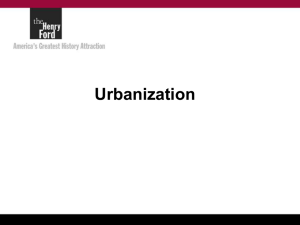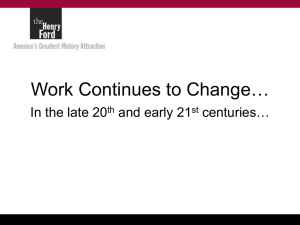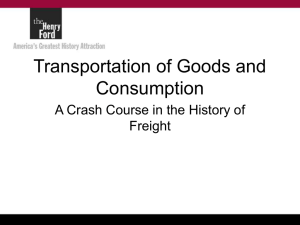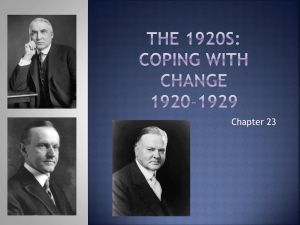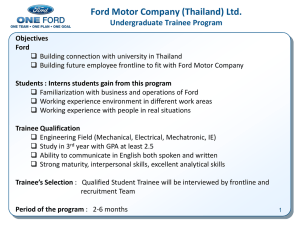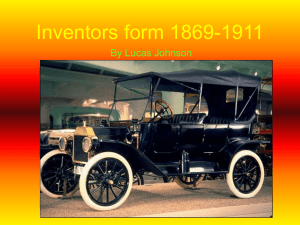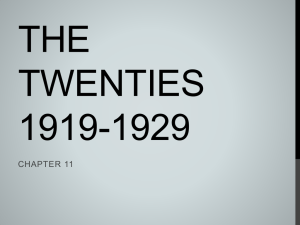Finding Jobs, Finding Problems Slideshow
advertisement
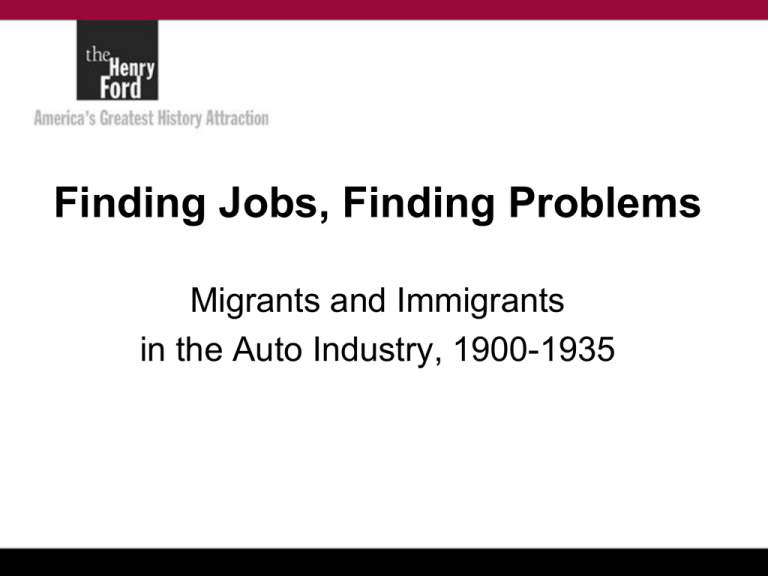
Finding Jobs, Finding Problems Migrants and Immigrants in the Auto Industry, 1900-1935 Part I: Finding Jobs An Urbanization Story • Henry Ford was only sixteen when he emigrated from his family’s farm in Dearborn, Michigan to Detroit, in 1879. • There he worked as an apprentice machinist for 3 years. • For the next 9 years, he repaired farm implements, worked on his family’s farm, and occasionally worked in Detroit factories. First Official Ford Motor Company Portrait of Henry Ford, 1904 From the Collections of The Henry Ford. ID#THF36449 An Urbanization Story • Henry Ford migrated to the city permanently in 1891. • He went on to provide jobs in Detroit factories for millions of people, many of whom, like him, grew up on farms. Crowd of Applicants outside Highland Park Plant after Five Dollar Day Announcement, January 1914 From the Collections of The Henry Ford. ID#THF4402 Define: Migration Emigration Urbanization Another Urbanization Story • Read Byron Moore’s urbanization story. Byron Moore, Head of Ford Rouge Plant Aircraft Engine Inspection and Repair, 1943 From the Collections of The Henry Ford. ID#THF68290. Farm Life at the Turn of the 20th Century • Farm work was hard labor and lasted from sunup to sundown. • The tasks farmers had to complete were different from day to day, and season to season. • Most people working on family farms owned the operation and were their own bosses. Some were extra workers hired if the family could afford it. Hay Wagon Coming up from a Meadow, Flushing, NY, circa 1900 From the Collections of The Henry Ford. ID#THF38312 Farm Life is Changing… Pushes From the Farm • Mechanization and technology save labor on the farm BUT… • Now there is less work in rural areas. • There are not jobs in rural areas when children grow up. Fordson Tractor, 1917, Used by Luther Burbank From the Collections of The Henry Ford. ID# THF72058 Factories are Changing… Pulls to the City • Luckily for them, mechanization and technology has also created new jobs in the city in factories and industries. • If these people come work in factories, they have jobs and Gas-Steam Engine, 1916, Used to Generate manufacturers have Electricity at Highland Park Plant employees. From the Collections of The Henry Ford. ID# THF52667 From South to North • The southern United States, being primarily agricultural, experienced this pull from the more industrialized North’s cities. • Both African Americans and whites migrated from the rural South to the urban North. Mattox House in Greenfield Village. Built about 1880 in Bryan County, Georgia. From the Collections of The Henry Ford. ID# THF70905 Immigration • Prior to the Civil War, most immigrants to America were from Western Europe. • In the decades after the Civil War and into the twentieth century, more immigrants were from Southern and Eastern Europe. Define: Immigration More Workers • Immigrants were pushed by mechanization of agriculture and pulled by manufacturing jobs. • Travel across the Atlantic in the steerage section of large passenger ships was made possible and cheaper by the technology of steam power. • Through letters home, immigrants encouraged family and friends to come join them. More Workers • Workers coming from places within the United States still weren’t enough labor to produce the number of automobiles Ford’s customers demanded . • Learn where Ford Motor Company workers came from in the document “Language and Citizenship of Ford Motor Company Employees, According to Nationality, as of January 12th, 1917.” From the Collections of The Henry Ford. ID#THF68283 Part II: Finding Problems Nature of Work • When you work on a group project, do you prefer doing one small part of the project or helping plan and work on the project from beginning to end? • Do you watch the clock while you’re in school, waiting for the day to end? Do you think you would do the same thing if you were working instead of learning? • Do you do better work when you are allowed to complete it independently or when you are closely supervised? For example, think about in-class work time versus homework or think about chores at home. Influence of workers’ prior experiences: Changing Nature of Work with Industrialization Farm • Involved in almost all aspects of farm work • Task focused • Most workers are independent Crops at Firestone Farm in Greenfield Village. From the Collections of The Henry Ford. ID# THF53081 Influence of workers’ prior experiences: Changing Nature of Work with Industrialization Factory • Completes small step in a long process • Time focused • Supervised by a foreman Time Clock, made 1916-1925, and Used by the Shelby Division of Copperweld From the Collections of The Henry Ford. ID# THF72059 Nature of Work • Letter from wife of a Ford factory worker Letter to Henry Ford from the Wife of an Assembly Line Worker, 1914 From the Collections of The Henry Ford. ID#THF32100 Influence of workers’ language Language Barriers • For student-workers: What was it like to not be able to communicate while you worked? Was it hard to learn your task? Did you feel you were doing as well as you would have had you been able to communicate? • For supervisor: What was it like to not be able to communicate with your workers? • For observers: How did you notice the language barrier affecting the assembly of the planes? Immigration Restrictions • Chinese Exclusion Act of 1882 – banned Chinese immigration to U.S. • Basic Naturalization Act (1906) - made speaking English a requirement for citizenship. • Emergency Quota Act of 1921 – set quotas per country for immigrants to US, favoring those from northern and western Europe, limiting those from southern and eastern Europe, and altogether banning those from Asia. Movement to and from Mexico, and Central and South America was quite free. Permanent quota system finalized in 1924. Influence of workers’ race: The Great Migration • In addition to being pushed from the rural South by a lack of jobs, African Americans were also pushed by racism and a lack of education opportunities for their children. • The movement of African Americans from the South to the Northeast, Midwest, and West is known as the Great Migration. Mattox House in Greenfield Village. Built about 1880 in Bryan County, Georgia. From the Collections of The Henry Ford. ID# THF70905 Why Families Left Home Source: Forrester B. Washington. The Negro in Detroit. 1920 Opportunities for AfricanAmerican Workers at Ford Motor Company •Ford Motor Company was largest employer in Detroit of African Americans •In 1919, Ford Motor Company employed 1700 African-American workers, 3% of its total workforce Workers in Ford Rouge Plant Cyanide Foundry, 1931 Source: Forrester B. Washington. The Negro in Detroit. 1920 From the Collections of The Henry Ford. ID#THF68318 Life for African-American Workers •Foundries had some of the largest percentages of AfricanAmerican employees in Detroit. •Some businesses limited AfricanAmericans to janitorial and the most unskilled jobs. •Some companies segregated their facilities. •Blacks not allowed to join social organizations within many workplaces Workers at the Ford Motor Company Rouge Plant Foundry, 1935 From the Collections of The Henry Ford. ID#THF68318 Other Problems for African-American Migrants • • • • Rent profiteering Terrible housing conditions Overcrowding Tension between native-Detroiter and native-Southern African Americans Immigrant and Migrant Worker Problems Summary Problems Faced by Migrants from Rural US Problems Faced by African American Migrants Problems Faced by Immigrants Immigrant and Migrant Worker Problems Summary Problems Faced by Migrants from Rural US Changed Nature of Work New language Discrimination New culture Problems Faced by African American Migrants Problems Faced by Immigrants
